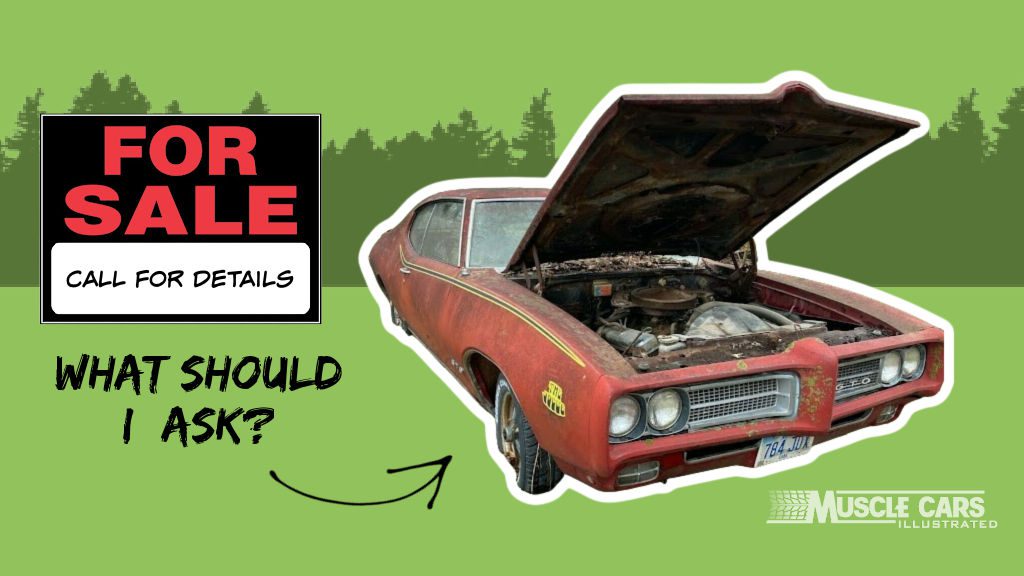
Surprisingly, many classified ads for classic muscle cars on the Internet leave much to be desired and raise more questions than they answer.
I’ve lost count of how many times I’ve seen a classified ad that shows only a handful of lousy exterior photos with a brief paragraph of nonessential details.
Arming yourself with a series of strategic questions can help save you time and get the most significant information upfront to sort the wheat from the chaff.
So, I compiled a list of the first ten essential questions to ask before buying a classic muscle car for sale so that you can get the most important details right out of the gate on your first call.
Let’s look at the first ten essential questions to ask before buying a classic muscle car, shall we?
Here we go:
Table of Contents
What questions should you ask before buying a classic muscle car?
These questions will help you determine how many value-adding details you can learn before you conduct a field assessment of the vehicle and make an offer.
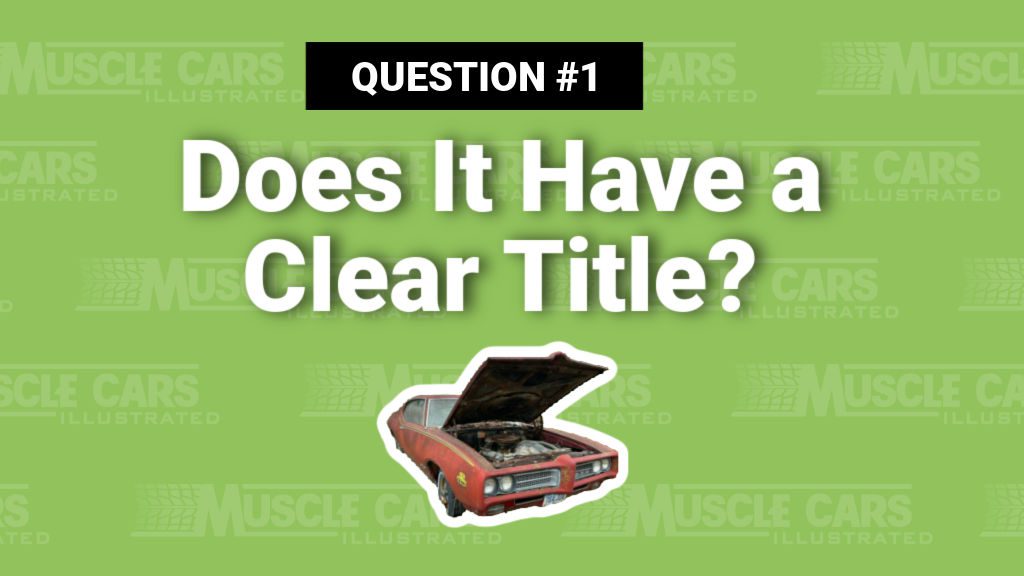
Does it have a clean/clear title?
Having a clear title means that the vehicle doesn’t have any liens on it, which means it is free and clear to be sold without challenge from a lienholder.
Having a “clear’ title is often confused with having a “clean” title, which is different but equally important to know and understand before making a purchase.
Having a clean title means the vehicle has never reported damage, which is the most desirable and valuable title status.
While a clean title doesn’t guarantee the car has never been in any accidents because not all accidents get reported, it’s as good an indicator as you can get that it is structurally sound.
If it had been in an accident, it would have a branded title that reflects what happened to the vehicle in the past, such as accident salvage, junk, flood damage, etc.
It’s important to note that some states don’t require a title to transfer ownership of a vintage vehicle. Instead, they only require a “bill of sale,” so the owner might not even have a title to sign over.
With a bill of sale, it’s easier to hide a vehicle’s damage history, so you need to take extra precautions under these circumstances to verify the vehicle’s actual structural condition.
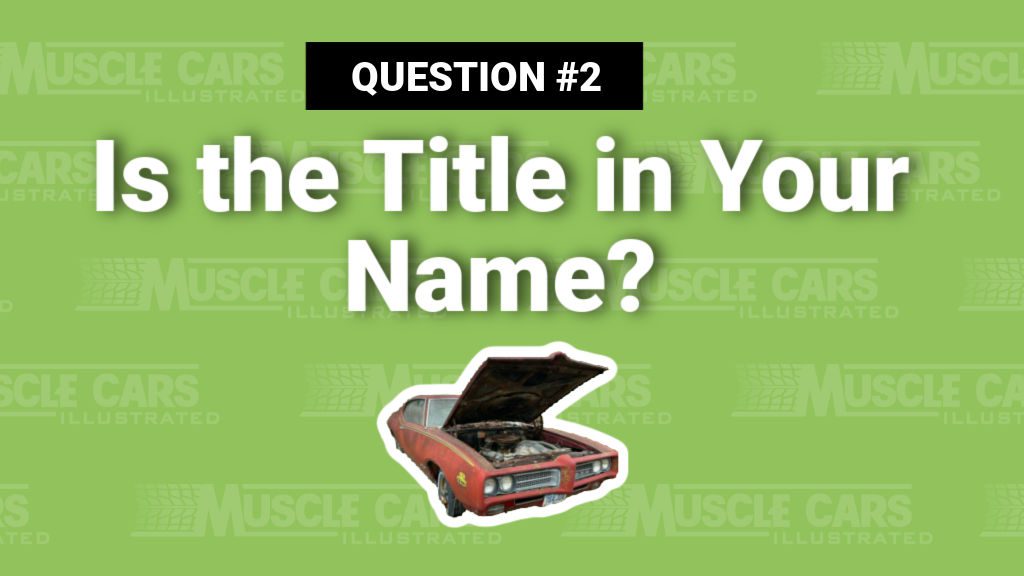
Is the title in your name?
Assuming a title is available and necessary, having it in the seller’s name is particularly important when purchasing a vehicle.
Having the title in the seller’s name means you’re dealing with the owner directly, who has the authority to sell the vehicle and transfer ownership.
Sometimes you have a family member selling a vehicle on behalf of a relative. In these cases, be sure that the actual owner signs over the title and/or bill of sale.
However, some classic car dealers sell vehicles on consignment, so the title might not be in their name. This is not necessarily a red flag because dealers receive authorization to sell the vehicle.
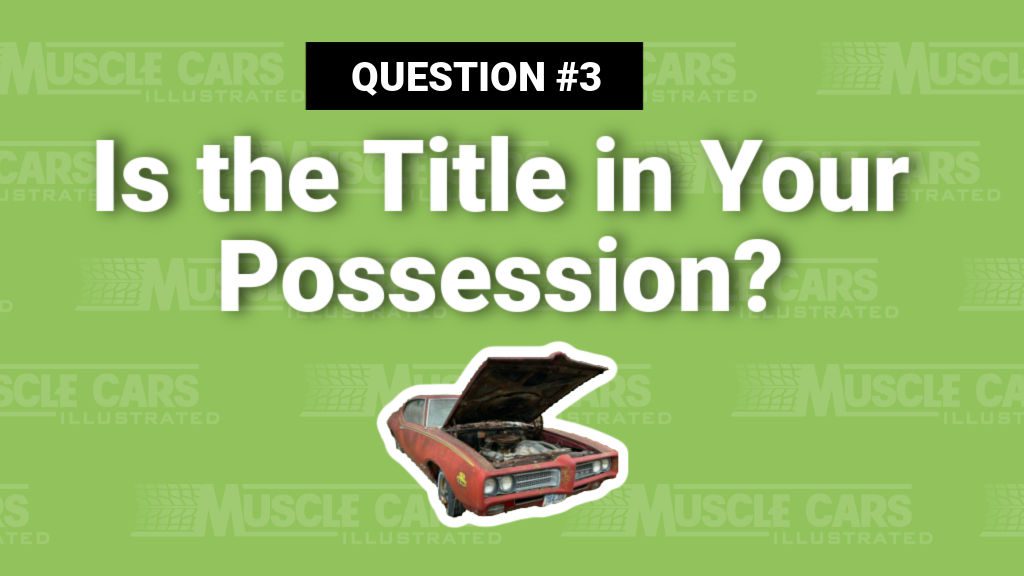
Is the title in your possession?
Asking if the title is in the seller’s possession is something many people don’t ask upfront and only learn about after making a deal.
Why does this happen? This can happen for a variety of reasons, including the seller doesn’t have or has lost the title, or there is an outstanding loan on the vehicle.
Sellers often list their muscle car for sale and then apply for a replacement title—hoping it arrives before they find a buyer. However, a buyer may appear before the new title arrives from the State.
Needless to say, it’s a precarious situation to complete the deal without the title—especially if it ends up being a stolen vehicle or there is still a lien on it.
While there are ways to work around these challenges, it’s best to know these things before you get your hopes up and think you’re going home with the car that day.
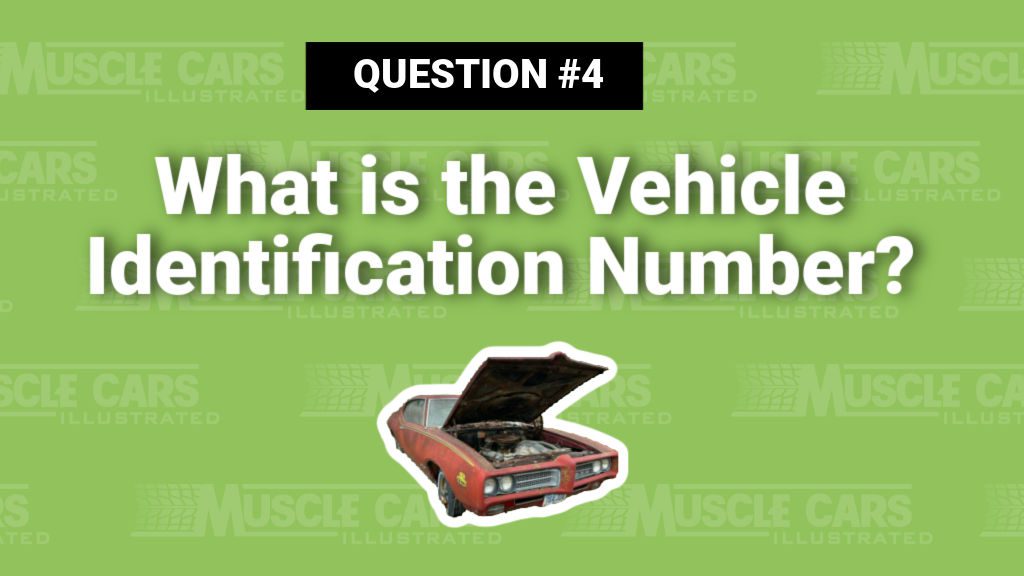
What is the Vehicle Identification Number?
A Vehicle Identification Number (VIN) is like a social security number, but for a vehicle. A VIN is a unique identifier for every vehicle and must 100% match the title and/or bill of sale.
If the VIN doesn’t exactly match the title and/or bill of sale, it is highly unlikely you will be able to register the car and get a new title in your name.
The DMV triple checks details like this to help prevent the registration of stolen vehicles. Don’t purchase a vehicle unless the title matches the exact vehicle identification number on the vehicle.
Knowing the VIN also helps you validate whether it is a numbers matching vehicle that you can compare against the chassis, engine block, and transmission stampings that show a partial VIN.
Additionally, a VIN can help you authenticate the original engine and model designation within the alphanumeric codes embedded in the VIN, depending on the manufacturer.
The VIN can provide valuable information to decode, especially if what you uncover differs from what the seller is representing in their ad.
Lastly, once you have the VIN, you can request a vehicle history report from companies like VinData.com, which specialize in vehicles with less than 17-digit VINs, as is the case with classic muscle cars.
Vehicle History Reports can tell you valuable information, such as title history, junk/salvage info, odometer history, open liens, theft recovery, inspection information, and more before purchase.
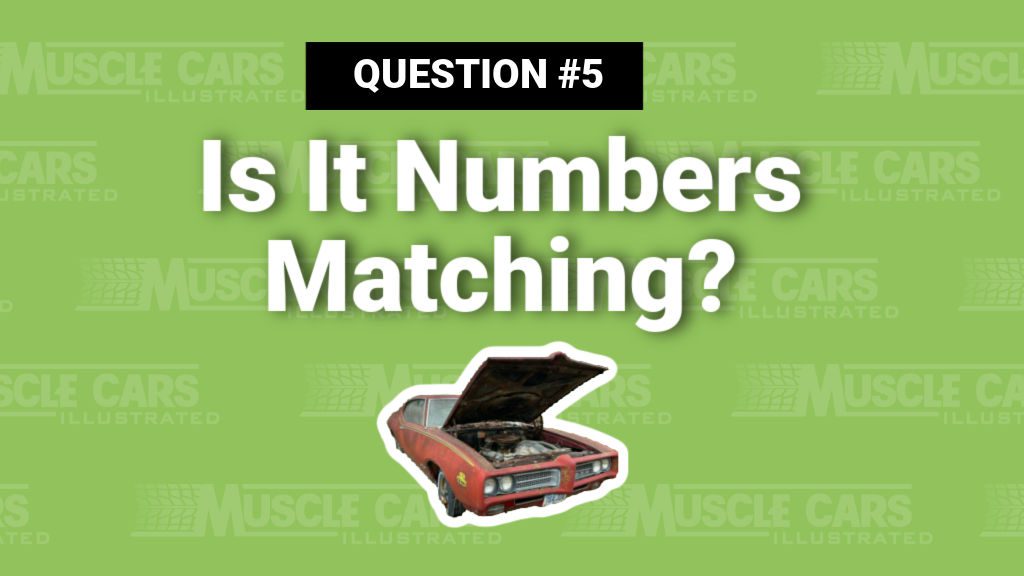
Is it numbers matching?
Having a numbers matching car is the most valuable and desirable version of a muscle car to own. Therefore, you want to know if everything matches or not because this directly impacts its value.
A numbers matching muscle car, broadly speaking, means the chassis number, engine, and transmission are all original to the vehicle and are not replacements.
When the numbers don’t match, you can usually get a better price, but the vehicle’s value won’t be as high—roughly 10%-20% less than if it did match—depending on how much is missing or changed.
However, it allows you to modify the vehicle without worrying that you’re impacting its value or that you’re altering a numbers matching vehicle.
While not everyone cares about numbers matching vehicles, it does add value to the purchase price and is worth paying up for if the opportunity presents itself.
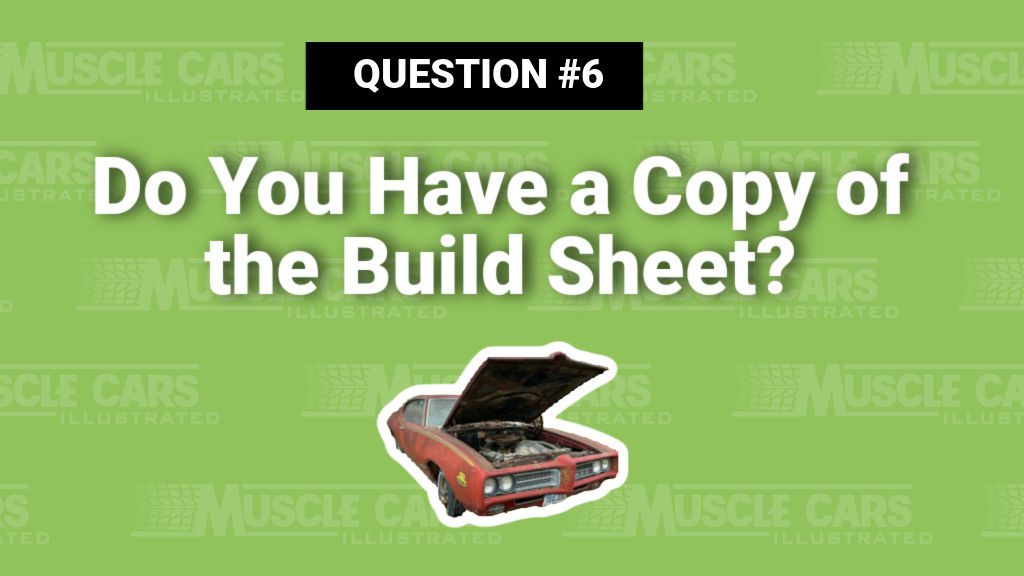
Do you have a copy of the build sheet?
A build sheet is a fragile piece of paper with a series of option codes used at the time of assembly so assemblers could match the right parts with the right vehicle as it went down the production line.
The build sheet validates the vehicle’s DNA and proves what options it came with from the factory. More importantly, it adds value because it authenticates the car’s provenance.
The seller might not have one, which may mean one is still in the vehicle, providing it hasn’t been removed or damaged along the way. The more original the vehicle, the more likely it is to find one.
While the location varies from factory to factory and manufacturer, you can start by looking under the front seats, rear seats, carpet, and door panels.
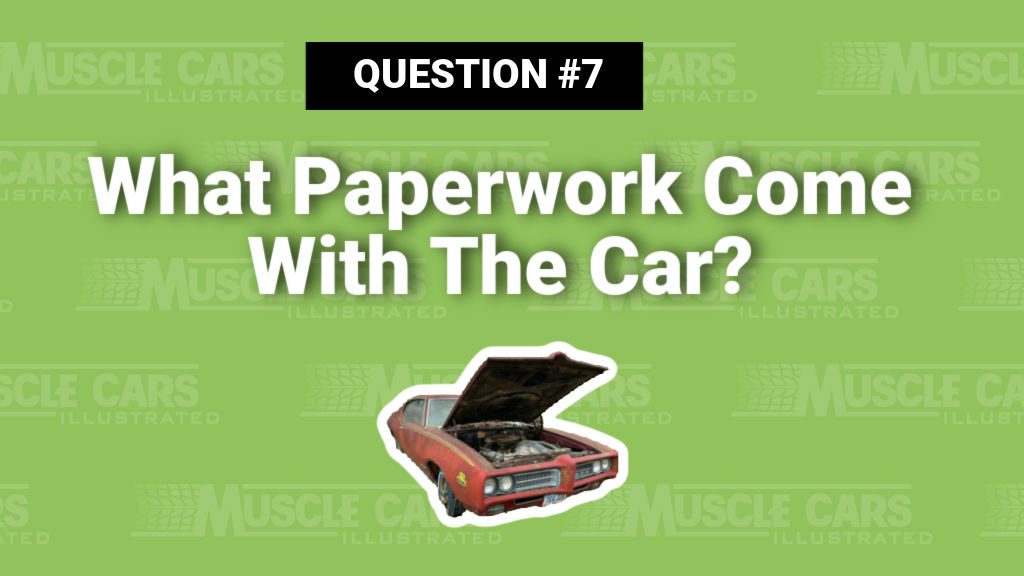
What paperwork comes with the car?
Asking for additional paperwork is an often overlooked step as the owner might not even think to offer it up at the time of sale.
Many sellers keep a folder of service and parts receipts during their ownership and help verify how well they maintained the vehicle during their ownership.
If you’re lucky, you might also get paperwork from previous owners as well, perhaps even a dealer invoice, sales receipt, warranty card, window sticker, or details about the original owner.
Discovering details about the original owner can help you track them down to ask if they have any original parts, share stories about the car, or send photos from when the vehicle was new.

Does it still have the fender tag/cowl tag/door tag?
Muscle cars typically have a tag or decal that is located on the vehicle’s inner fender, cowl, or door jam that identifies other vital information besides the VIN.
If the tag is missing, verifying the original engine, transmission, axle gear ratios, trim, paint color, vinyl top color, etc. might not be possible—especially if the original paperwork or build sheet is also missing.
- GMs have a metal stamped tag on the driver’s side cowl (firewall).
- Fords have a metal stamped tag in the driver’s side door jam.
- AMCs have a decal in the driver’s side door jam.
- Mopars have a metal fender tag on the driver’s side inner fender.
- Mopars also have a decal in the driver’s side door jam.
While replacement tags are available, companies usually need a pencil rubbing of the VIN, proof of ownership, and either a broadcast sheet, dealer invoice, or window sticker to recreate one.
Without these documents, it can prove challenging to get a replacement. While you may be okay with it now, it may prove troublesome when you go to sell it and are lowballed because it’s still missing.
If the correct tag is missing or is from a different vehicle, it lessens the value of the vehicle and should be factored into your offer.

Are there any extra parts that go with it?
Always ask if any extra parts come with the purchase—particularly if the original engine and transmission are missing.
While the seller might not include any extra parts in your deal or have any to offer, it’s always in your best interest to ask before closing a deal and leaving empty-handed.
Extra parts might include valuable original items frequently removed, including air conditioning brackets and hardware, radio, vinyl top moldings, wheels, air cleaner, exhaust manifolds, etc.
Sometimes you have to pay extra for the parts, while other times, they’ll be thrown into the deal.
If you decide not to purchase the vehicle, you could always try to buy any extra parts separately if they are of interest to you.
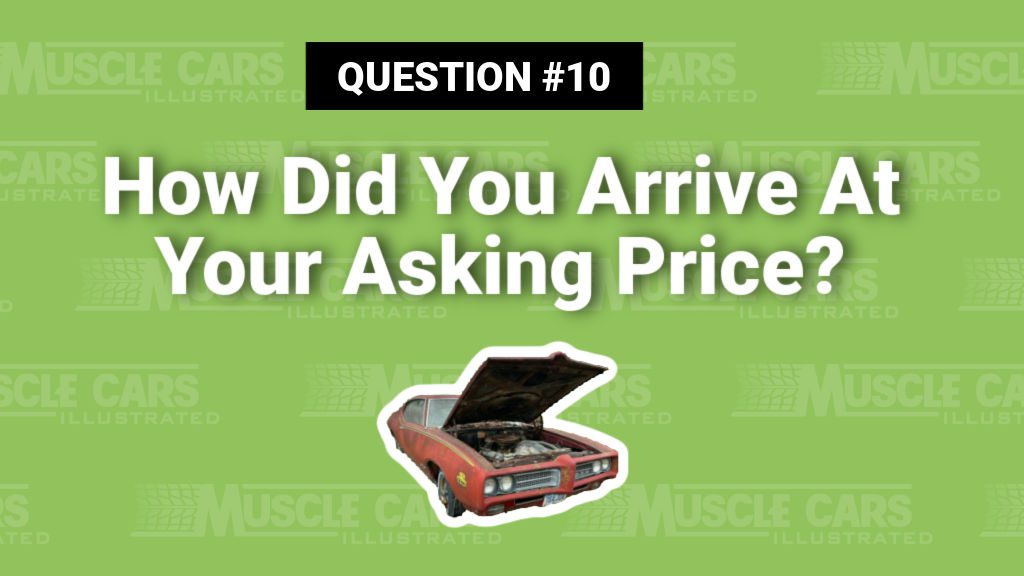
How did you arrive at your asking price?
Understanding how a seller arrived at their asking price is another important question that is often overlooked.
Asking this question will help you unravel the factors they deem most important to the sale, so you know how best to counter them.
Asking this question early on in the process gives you time to think through how to build a case that the vehicle is either not worth as much as they think or if they know what they’re talking about.
Many sellers will reveal critical details after being asked this question that you can use to either dispute or agree with their assumptions.
Without asking this question, you’re only guessing how they arrived at the price and may be unable to talk them down properly.
Well, there you have part one of the ten essential questions to ask before buying a classic muscle car. What would you add to the list in part two?
Take Our Poll!
"*" indicates required fields
Ryan
Ryan has owned muscle cars since 1986 and currently owns a 1972 Dodge Charger Rallye. He combines passion and experience to create engaging content for fellow muscle car enthusiasts. In 2018, he founded Muscle Cars Illustrated, authoring hundreds of articles on tips, history, and trends in the muscle car industry. He attends national car shows, auctions, and museums to stay current with the latest developments in the muscle car industry.Comments
Comments are closed.

Good info to have if one is just starting out in this world of classic Vehicles. There are a lot of Wolves hiding out in in Red Riding Hood’s Forest.
Great article. Thank You! Geo